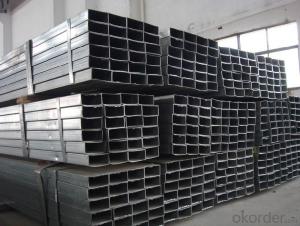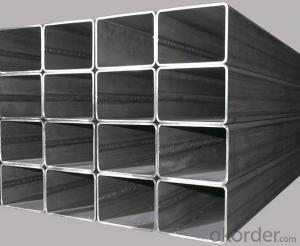Hollow Section Steel Pipe Various Size Good Quality
- Loading Port:
- Tianjin
- Payment Terms:
- TT or LC
- Min Order Qty:
- 25 m.t.
- Supply Capability:
- 10000 m.t./month
OKorder Service Pledge
OKorder Financial Service
You Might Also Like
1、Structure of Hollow Section Steel Pipe Various Size:
To be used for construction, furniture structures as well as other fabrication purposes.
2、Main Features of Hollow Section Steel Pipe Various Size:
• High manufacturing accuracy
• High strength
• Small inertia resistance
• Strong heat dissipation ability
• Good visual effect
• Reasonable price
3、Hollow Section Steel Pipe Various Size Specification:
Standard | ASTM A500, GB6728 |
Grade | A, B, C, Q195, Q235, Q215 |
Thickness | 0.6-10MM |
Section Shape | Square |
Outer Diameter | 10*10-500*500 |
Place of Origin | TIANJIN, China (Mainland) |
Secondary Or Not | Non-secondary |
Application | Hydraulic Pipe |
Technique | HOT-ROLLED |
Certification | CO, MTC, CI, PL |
Surface Treatment | factory state or painted black |
Special Pipe | |
Alloy Or Not | Non-alloy |
Length | 5-12M |
Outer Diameter | 10*10-500*500 |
1) Material: A, B, C, Q195, Q235, Q215
2) Specification range: 10*10-500*500 WT:0.6-10MM ,length:6-12m or according to the requirement of clients.
3) Excutive standards:GB,ASME API5L.ASTM A 106/A53,Despite of the above standards,we can also supply seamless steel pipe with standard of DIN,JIS,and so on,and also develop new products according to the requirements of our clients!
4) Surface:black lacquered,varnish coating or galvanized.
5) Ends:Beveled or square cut,plastic capped,painted.
6) Packing:bundles wrapped with strong steel strip,seaworthy packing.
4、Packaging & Delivery
Packaging Details: | seaworthy package,bundles wrapped with strong steel strip |
Delivery Detail: | 15-30days after received 30%TT |
5、FAQ of Hollow Section Steel Pipe Various Size:
①How is the quality of your products?
Our products are manufactured strictly according to national and internaional standard, and we take a test
on every pipe before delivered out. If you want see our quality certifications and all kinds of testing report, please just ask us for it.
Guaranteed: If products’ quality don’t accord to discription as we give or the promise before you place order, we promise 100% refund.
②How about price?
Yes, we are factory and be able to give you lowest price below market one, and we have a policy that “ for saving time and absolutely honest business attitude, we quote as lowest as possible for any customer, and discount can be given according to quantity”,if you like bargain and factory price is not low enough as you think, just don’t waste your time.Please trust the quotation we would give you, it is professional one.
6、Hollow Section Steel Pipe Various Size Images:

- Q: Can steel pipes be used for natural gas distribution?
- Yes, steel pipes can be used for natural gas distribution. Steel pipes are commonly used in natural gas distribution systems due to their high strength, durability, and resistance to corrosion. They can safely transport natural gas over long distances and are widely accepted in the industry for this purpose.
- Q: How are steel pipes used in the manufacturing of aerospace components?
- Steel pipes are used in the manufacturing of aerospace components as they provide structural support and durability. They are commonly used for fuel and hydraulic systems, allowing for the safe and efficient transfer of fluids throughout the aircraft. Additionally, steel pipes are utilized in the fabrication of engine components and airframe structures, ensuring strength and reliability in the demanding aerospace environment.
- Q: Can steel pipes be used for automotive applications?
- Indeed, automotive applications do involve the utilization of steel pipes. In the automotive industry, steel pipes find frequent application in exhaust systems, fuel lines, and hydraulic systems, among other purposes. The key attributes of steel pipes, such as their remarkable strength, durability, and resistance to corrosion, render them well-suited for enduring the challenging conditions and requirements of automotive applications. Moreover, steel pipes offer the added advantage of being effortlessly shaped and welded, facilitating customization and simplified installation. All in all, steel pipes offer a dependable and economically viable solution for automotive applications.
- Q: What is the difference between hot-dip galvanizing and electroplating for steel pipes?
- Steel pipes can be protected from corrosion using hot-dip galvanizing or electroplating, but these methods have distinct differences. With hot-dip galvanizing, the steel pipes are immersed in molten zinc, creating a strong bond with the steel. This results in a thick and durable zinc coating that effectively prevents corrosion. The entire surface of the pipe, both inside and outside, is uniformly covered, making hot-dip galvanizing ideal for comprehensive protection. Electroplating, on the other hand, involves depositing a thin layer of metal, usually zinc, onto the steel surface using an electric current. Unlike hot-dip galvanizing, electroplating does not form a metallurgical bond between the zinc and steel. Instead, it forms a mechanical bond, which is weaker and less long-lasting. The electroplated zinc layer is also thinner, offering less corrosion protection compared to hot-dip galvanizing. The application process is another point of differentiation. Hot-dip galvanizing requires immersion in molten zinc, which can be time-consuming. Electroplating, on the other hand, uses an electrolytic cell for zinc coating application, which is faster and more efficient. In conclusion, the thickness, durability, and bonding mechanism between zinc and steel distinguish hot-dip galvanizing from electroplating for steel pipes. Hot-dip galvanizing provides a thicker, longer-lasting coating with a metallurgical bond, making it superior for extended corrosion protection. Electroplating, however, creates a thinner coating with a mechanical bond, suitable for applications where a less robust level of corrosion resistance is acceptable.
- Q: How are steel pipes used in nuclear power plants?
- Steel pipes are used in nuclear power plants for various purposes, including transporting coolant, steam, and other fluids, as well as providing structural support for the plant's infrastructure.
- Q: What are the common uses of steel pipes in construction?
- Steel pipes are commonly used in construction for various purposes such as carrying water, gas, and sewage, as well as for structural support in building frameworks, bridges, and underground piping systems. They are also used in the transportation of fluids and materials, making them essential in industries like oil and gas, manufacturing, and infrastructure development.
- Q: How are steel pipes protected against ultraviolet radiation?
- Steel pipes are typically protected against ultraviolet radiation by applying a layer of protective coating or paint. This coating acts as a barrier, preventing the harmful effects of UV rays from deteriorating the steel and reducing its lifespan.
- Q: How do you calculate the pipe flow velocity for steel pipes?
- To determine the velocity of flow in steel pipes, two equations can be utilized: Manning's formula or the Darcy-Weisbach equation. 1. Manning's formula, commonly applied to open channel flow but also suitable for partially filled pipes, calculates velocity based on the pipe's hydraulic radius, slope, and Manning's roughness coefficient. The formula is as follows: Velocity (V) = (1.486/n) * (R^2/3) * (S^1/2) In this formula: - V represents the velocity - n denotes the Manning's roughness coefficient (obtainable from reference tables) - R signifies the hydraulic radius (cross-sectional area divided by wetted perimeter) - S indicates the slope of the energy grade line 2. The Darcy-Weisbach equation, widely used for pipe flow calculations, derives velocity from the pipe's diameter, roughness coefficient, and head loss due to friction. The equation is as follows: Velocity (V) = (2 * g * hL)^0.5 In this equation: - V represents the velocity - g stands for the acceleration due to gravity (approximately 9.81 m/s^2) - hL refers to the head loss caused by friction, which can be calculated using the Darcy-Weisbach equation: hL = (f * L * V^2) / (2 * g * D) In this equation: - f denotes the Darcy friction factor (dependent on the Reynolds number and pipe roughness) - L represents the length of the pipe - D indicates the diameter of the pipe Both formulas necessitate input parameters such as pipe dimensions, roughness coefficients, and slope. These parameters can be obtained from engineering references or pipe manufacturer specifications. It is essential to note that these formulas provide approximate values and may require iterations or adjustments for precise outcomes.
- Q: How are steel pipes used in the construction of airports?
- Steel pipes are commonly used in the construction of airports for various purposes such as drainage systems, water supply lines, fuel pipelines, and structural supports. They provide durability, strength, and corrosion resistance, ensuring the efficient operation and safety of airport infrastructure.
- Q: How are steel pipes protected against internal scaling?
- Steel pipes are protected against internal scaling through various methods such as chemical treatments, use of corrosion inhibitors, and regular maintenance and cleaning procedures. These measures help to prevent the formation of scale, which can reduce the pipe's efficiency and lifespan.
Send your message to us
Hollow Section Steel Pipe Various Size Good Quality
- Loading Port:
- Tianjin
- Payment Terms:
- TT or LC
- Min Order Qty:
- 25 m.t.
- Supply Capability:
- 10000 m.t./month
OKorder Service Pledge
OKorder Financial Service
Similar products
Hot products
Hot Searches
Related keywords


























